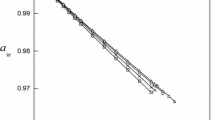Abstract
The electrolyte-NRTL model was used to describe the thermodynamic excess properties and the liquid composition of aqueous hydrofluoric acid solutions for overall HF concentrations ranging from dilute to a molality of 20 mol⋅kg−1. Within the framework of this model, three different mechanisms were tested. The first one considers only the dissociation of HF into H+ and F−. The second mechanism takes into account the dissociation of HF and the chemical reaction for formation of HF −2 . The third mechanism considers, in addition to these two chemical reactions, the reaction that leads to formation of the dimer H2F −3 . The experimental osmotic coefficients of the HF + H2O system were used to estimate the interaction parameters of this model. The resulting parameters yield an accurate description of the Gibbs-Duhem relation for the three mechanisms. The estimated liquid phase speciation for fluoride in the HF+H2O system is comparable to the experimental values of Braddy et al.
Similar content being viewed by others
Abbreviations
- a i :
-
activity of species i
- A φ :
-
Debye-Hückel constant
- f i :
-
mole fraction of activity coefficients
- G ji :
-
electrolyte-NRTL parameters
- G ji,ki :
-
electrolyte-NRTL parameters
- I x :
-
mole fraction ionic strength
- K :
-
chemical equilibrium constant on the molal scale
- m i :
-
molality of species i
- M s :
-
molecular weight of the solvent
- n :
-
mole number
- N :
-
number of experimental points
- p :
-
parameter number
- R :
-
gas constant
- T :
-
temperature
- x i :
-
liquid phase mole fraction of species i
- x ij :
-
effective local mole fraction of species i around the central species j
- z i :
-
absolute charge number of ionic species i
- γ i :
-
molal activity coefficient of species i
- φ :
-
osmotic coefficient
- ρ :
-
Electrolyte-NRTL parameter
- τ ji ,τji,ki:
-
interaction parameters
- α :
-
nonrandom factor
- cal:
-
calculated
- exp :
-
experimental
- ex:
-
excess
- lc:
-
local composition
- pdh:
-
Pitzer-Debye-Hückel
- ∞:
-
infinite dilution
- *:
-
unsymmetric
- a :
-
anion
- c :
-
cation
- i,j,k:
-
any species
- m :
-
molecule
References
Hefter, G.T.: Acidity constant of hydrofluoric acid. J. Solution Chem. 13, 457–470 (1984)
Miki, N., Maeno, M., Ohmi, T.: Vapor-liquid equilibrium of the binary system HF–H2O extending to extremely anhydrous hydrogen fluoride. J. Electrochem. Soc. 137, 787–790 (1990)
Warren, L.J.: The measurements of pH in acid fluoride solutions and evidence for existence of (HF)2. Anal. Chim. Acta 53, 199–202 (1971)
Stenstrom, S.: Purification of wet process phosphoric acid by solvent extraction with long-chain amines. Ph.D Thesis, LUTKDH/(TKKA-1003), Lund University (1986)
Bromley, L.A.: Thermodynamic properties of strong electrolytes in aqueous solutions. AIChE J. 19, 313–320 (1973)
Hamer, W.J., Wu, Y.-C.: Osmotic coefficients and mean activity coefficients of uni-univalent electrolytes in water. J. Phys. Chem. Ref. Data 1, 1047–1099 (1972)
Wang, P., Anderko, A., Young, R.D.: A speciation-based model for mixed-solvent electrolyte systems. Fluid Phase Equil. 203, 141–176 (2002)
Saliminen, J., Kobylin, D., Liukkonen, S., Filho, O.C.: Gibbs energy approach for aqueous processes with HF, HNO3, and CO2–CaCO3. AIChE J. 50, 1942–1947 (2004)
Kolasinski, K.: The composition of fluoride solutions. J. Electrochem. Soc. 152, J99–J104 (2005)
Chen, C.C., Britt, H.I., Boston, J.F., Evans, L.B.: Local composition model for excess Gibbs energy of electrolyte systems. Part I: Single solvent, single completely dissociated electrolyte systems. AIChE J. 28, 588–596 (1982)
Chen, C.C., Evans, L.B.: A local composition model for the excess Gibbs energy of aqueous electrolyte systems. AIChE J. 32, 444–454 (1986)
Broene, H.H., de Vries, T.: The thermodynamics of aqueous hydrofluoric acid solutions. J. Am. Chem. Soc. 69, 1644–1946 (1947)
Baumann, E.W.: Determination of stability constants of hydrogen and aluminum fluorides with a fluoride-selective electrode. J. Inorg. Nucl. Chem. 26, 1959–1965 (1964)
Kresge, A.J., Chiang, Y.: Solvent isotope-effects on ionization of hydrofluoric-acid. J. Phys. Chem. 77, 822–825 (1973)
Braddy, R., McTigue, P.T., Verity, B.: Equilibria in moderately concentrated aqueous hydrogen fluoride solutions. J. Fluorine Chem. 66, 63–67 (1994)
Messnaoui, B., Bounahmidi, T.: Modeling of excess properties and vapor–liquid equilibrium of the system H3PO4–H2O. Fluid Phase Equil. 237(1–2), 77–85 (2005)
Marquardt, D.W.: An algorithm for least squares estimation of nonlinear parameters. J. Soc. Indus. Appl. Math. 11, 431–441 (1963)
Liu, Y., Watanasiri, S.: Successfully simulate electrolyte systems. Chem. Eng. Prog. 25–42 (1999)
Author information
Authors and Affiliations
Corresponding author
Rights and permissions
About this article
Cite this article
Messnaoui, B. Representation of Excess Properties and Liquid Composition of Aqueous Solutions of the HF+Water System. J Solution Chem 37, 715–726 (2008). https://doi.org/10.1007/s10953-008-9272-4
Received:
Accepted:
Published:
Issue Date:
DOI: https://doi.org/10.1007/s10953-008-9272-4



